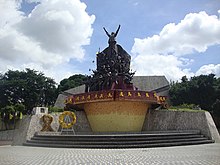| This article needs additional citations for verification. Please help improve this article by adding citations to reliable sources. Unsourced material may be challenged and removed. Find sources: "People Power Monument" – news · newspapers · books · scholar · JSTOR (January 2019) (Learn how and when to remove this message) |
| Monumento ng Lakas ng Bayan | |
 People Power Monument decorated with yellow ribbons during Ninoy Aquino Day People Power Monument decorated with yellow ribbons during Ninoy Aquino Day | |
| 14°36′00″N 121°03′36″E / 14.60000°N 121.06000°E / 14.60000; 121.06000 | |
| Location | Barangay Camp Aguinaldo, Quezon City, Philippines |
|---|---|
| Designer | Eduardo Castrillo |
| Height | 18 m (59 ft) |
| Opening date | 1993 |
| Dedicated to | The memory of the EDSA People Power Revolution |
The People Power Monument is an 18-meter-high (59 ft) monument built to commemorate the events of the 1986 People Power Revolution. The monument is located on the corner of Epifanio de los Santos Avenue and White Plains Avenue in Barangay Camp Aguinaldo, Quezon City, Philippines. It was made by Eduardo Castrillo in 1993. It is about 0.90 kilometers (0.56 mi) from the EDSA Shrine, another monument built to commemorate the event.
Description
The monument is set atop an elevated position and is pyramidal in composition. The first and middle tiers are composed of statues of people from all sectors of the society. The first tier is composed of a chain of men and women with arms linked together. One man at the end of the chain, who is identified as Ninoy Aquino, is pointing towards EDSA Shrine and the Ortigas Area.
The middle tier represents various people, young and old, who had joined the protest; some of the statues are that of a musician, a mother carrying an infant, a man sporting the "Laban" sign, and priests and nuns. On the top tier of the monument is a towering female figure with arms raised toward the sky. The figure have unchained shackles on her wrist which represent freedom. From the back of the composition rises a large flag and staff.
As with any other artistic works in the Philippines, the monument is protected by copyright according to the Intellectual Property Office of the Philippines.
November 2016 protests
In November 2016, the monument became a gathering point where anti-Marcos groups, Martial Law victims and political figures gathered at the monument to denounce the surprise burial of Ferdinand Marcos at the Libingan ng mga Bayani (Hero's Cemetery) that took place on November 18, 2016. Protesters condemned the hero's burial citing wide-scale plunder and human rights abuses during the Marcos dictatorship. Members and former members of the Cabinet were among the protesters.
7 Symbols of Peace nomination
In May 2018, the monument was nominated as one of the seven symbols of world peace through the #7Peace #PeoplePower initiative.
Gallery
See also
- Ferdinand Marcos
- EDSA Revolution of 2001
- EDSA Shrine
- Bantayog ng mga Bayani
- EDSA Tres
- Joseph Estrada
- Gloria Macapagal Arroyo
- People Power Revolution
References
- Esposo-Ramirez, Veronice. "Freeing the Filipino through Monumental Sculpture" (PDF). Synergeia. University of Asia & the Pacific. pp. 155–158. Retrieved March 27, 2023.
- "Spirit of Edsa Foundation". Spirit of Edsa Foundation. Retrieved March 29, 2024.
- Intellectual Property Office of the Philippines (February 25, 2020). "The People Power Monument, a structure built to commemorate the #EDSA revolution, was sculptured by Eduardo Castrillo in 1993 and is comprised of 37 figures depicting the various sectors of the Philippine society that joined the People Power Revolution in 1986". Facebook. Retrieved November 14, 2020.
The People Power Monument, a structure built to commemorate the #EDSA revolution, was sculptured by Eduardo Castrillo in 1993 and is comprised of 37 figures depicting the various sectors of the Philippine society that joined the People Power Revolution in 1986. Did you know that the People Power Monument, like any other artistic work, is protected by #copyright?
- "Photos: Aerial view of rallies against Marcos' burial". Philstar.com. November 18, 2016. Retrieved February 11, 2023.
- ^ Hincks, Joseph (December 1, 2016). "Filipinos Are Outraged at Attempts to Rehabilitate Marcos". Time. Retrieved February 11, 2023.
- "VistaPinas". VistaPinas. Retrieved November 6, 2010.
- "Activists occupy People Power Monument to protest Marcos burial". ABS-CBN News. December 1, 2016.
- "7 Symbols of Peace". 7symbolsofpeace.com. Retrieved January 25, 2019.
External links
 Media related to People Power Monument at Wikimedia Commons
Media related to People Power Monument at Wikimedia Commons
| Visitor attractions in Metro Manila | |
|---|---|
| Historical sites | |
| Religious buildings | |
| Museums and galleries |
|
| Integrated resorts | |
| Amusement |
|
| Parks and gardens | |
| Shopping | |
| Events and traditions | |
| Event venues | |
| By type | |

